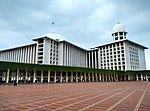Mohammad Misbach

Mohammad Misbach (c. 1876–1926), commonly known as Haji Misbach, was a communist and Islamic activist from Surakarta, Dutch East Indies.[1][2][3] He was a leading member of the left wing of the Sarekat Islam organization in the 1910s and famously advocated for the compatibility of Islam and communism.
Biography[edit]
Misbach was born Achmad in Kauman, Surakarta, Dutch East Indies in around 1876.[1][2] He was the son of a wealthy Batik trader and received a traditional Islamic education in a Pesantren, as well as a brief eight-month period in a government school.[1] He entered the Batik trade and became fairly wealthy, owning his own workshop.[1] When he got married he changed his name to Darmodiprono; however, after making the Hajj he changed his name once again to Hadji Mohammad Misbach.[1]
When the Sarekat Islam was founded in Surakarta in 1912, he joined, although he was initially not prominent.[1] Misbach started to become well-known among the reformist generation in Surakarta (called kaum muda or young group); he became more active in 1914 when he joined Marco Kartodikromo's League of Native Journalists (Dutch: Inlandsche Journalisten Bond).[1] In 1915 he became even better known after he acted as leader of local people in Surakarta who were opposed to the Dutch "anti-plague" policies which involved the partial demolition of native homes.[2] He refused to have alterations made to his own house until he was ordered to by a magistrate.[2]
In 1915 Misbach helped cofound a left-wing Islamic monthly magazine named Medan Moeslimin (Muslim forum) as a response to increasing Christian missionary publications in Java.[4][5]
In 1917 he launched a new daily newspaper called Islam Bergerak (Islam in Motion).[1] He also opened a hotel, the Hotel Islam, along with a bookstore and religious school.[1] During this time he was a close ally of Muhammadiyah, its founder Ahmad Dahlan and his protege Hadji Fachrodin.[1] He also continued to be active in campaigning against the Dutch "anti-plague" policies; in 1918 the Insulinde party appointed him as local investigator of the matter and allowed him to found new local branches outside Surakarta to expand the campaign.[2]
In 1918, Misbach and some of his more Islamically-minded allies (including Oemar Said Tjokroaminoto) entered into a dispute with some parts of the nationalist movement over the publications of content in the Surakarta newspaper Djawi-Hisworo which they deemed disrespectful to Muhammad.[1][2] They founded a counter-organization named Sidik Amanat Tableg Vatonah (TKNM, "To confirm, convey, and propagate goodness").[1] They held immense protest rallies, some of which had twenty thousand people in attendance.[1] The main activity of the group was to send letters of complaint to the colonial government; it eventually fell apart over disputes about fundraising.[1]
After that he began to campaign in the countryside, moving beyond local influence in Surakarta for the first time.[2] He became a propagandist in the countryside against the regressive Corvée forced labour system through which peasants had to do unpaid work or risk being expelled from their land.[2]
He was released from prison in August 1922.[6]
With the 1923 split of the Sarekat Islam into left and right wings, he followed most of the left wing into the PKI (Indonesian Communist Party). After a bombing in Surakarta, Haji Misbach was blamed and exiled to New Guinea.[7]
References[edit]
- ^ a b c d e f g h i j k l m n Shiraishi, Takashi (1990). An age in motion : popular radicalism in Java, 1912-1926. Ithaca: Cornell University Press. pp. 127–38. ISBN 0801421888.
- ^ a b c d e f g h Larson, George D. (1987). Prelude to revolution : palaces and politics in Surakarta, 1912-1942. Dordrecht, Holland: KITLV. pp. 101–3. ISBN 9067652172.
- ^ Ricklefs, Merle Calivin (2001). A History of Modern Indonesia since c. 1200. Stanford University Press.
- ^ "Nederlandsch-Indie". De nieuwe vorstenlanden (in Dutch). Surakarta. 16 January 1915. p. 2.
- ^ Shiraishi, Takashi (1990). An age in motion : popular radicalism in Java, 1912-1926. Ithaca: Cornell University Press. p. 80. ISBN 0801421888.
- ^ Larson, George D. (1987). Prelude to revolution : palaces and politics in Surakarta, 1912-1942. Dordrecht, Holland: KITLV. pp. 1123–8. ISBN 9067652172.
- ^ McVey, Ruth (2006). The Rise of Indonesian Communism. Singapore: Equinox.


 French
French Deutsch
Deutsch